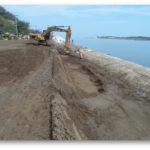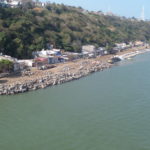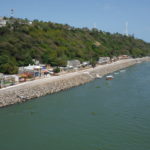Company:
Flint Industries Inc. Metter, GA
Project Details
Fabric 1
Flintex ™ OS 425 FW/RS
Producer:
Flint Industries
Supplier:
FTG Group (Jorge Perez)
Design Company
SubmarElher
Fabrication Company
Flint Industries
Installation Name
David Zamorano
Installation Company
SubmarElher
Please describe the project specifications
The design consisted of a geotextile tube revetment installed along 1,560 linear feet (475m) of the shoreline along the street 15 de Octubre in La Tro
cha, Veracruz state, Mexico, a small community near Alvarado. The revetment design included the installation of 19 sand-filled geotextile tubes of 45 feet (13.7m) circumference by 82 feet (25m) in length. This design required approximately 20,000 cubic yards (15,300 m3) of sand backfill, 43,200 US tons (39,200 metric tons) of armor stone and 360,000 square feet (33,445 m2) of asphalt paving. The geotextile tubes contained approximately 7,000 cubic yards (5,385 cubic meters) of fill sand and did not require an anti-scour apron, as is the custom for geotextile tube structures used for coastal protection, due to the use of 2 layers of nonwoven geotextile draped over the geotextile tubes before the application of armor stone. The geotextile tube revetment system extended from a toe elevation of -3.5 feet (-1.07m) NAVD to a crest elevation of +8.5 feet (+2.59m) NAVD. The revetment will provide protection to the community and has a lifespan of approximately 30 years.
The TITANTube® geotextile tubes utilized on this project were made of an innovative high strength woven polypropylene fabric that was designed with
rip-stops to minimize any puncture rips from propagating, resulting in catastrophic failure. Additionally, the fabric utilized in these tubes featured an extremely high UV rating (significantly higher than contemporary tube fabrics),
as well as having a higher angle of friction to minimize armor stone slippage. Each of these attributes served to extend the design life of not just the product, but the overall project as well. The tubes were also constructed of
sand colored fabric so, should the geotextile tubes on slope ever be exposed, it would appear aesthetically pleasing to its surroundings.
What was the purpose of this project? What did the client request?
The Laguna de Alvarado, fed by the Papaloapan River, as well as several smaller ones, is a biodiverse coastal lagoon of international importancelocated in Mexico’s Veracruz State. It is separated from the Gulf of Mexico by a littoral barrier with sand dunes reaching up to 165 feet in height. The only access to the sea is by a short channel from the lagoon to the Gulf of Mexico. Several shoreline alterations, land reclamation and alterations to adjacent wetlands have occurred in the past but severe erosion still persisted. The source of the erosion was determined to be a combination of the channel’s current and ship wakes. The banks of the channel had rapidly eroded resulting in a hazardous environment for the La Trocha population on the west bank. Between 2005 to 2010, erosion had been so severe that as much as 130 feet (40m) of dry beach in some areas has been lost. Other contributors of this erosion and damage
to the ecosystem were seasonal agriculture, livestock production, polluted sewer discharges and deforestation of dune vegetation.
Additionally, the construction of hydroelectric dams has severely alter
ed the hydrologic network and has reduced the overall sediment supply to the system. The sedimentary imbalance had resulted in large silted areas where the water does not have enough velocity to transport the material, causing it to prematurely drop out of suspension and not be deposited along the riverbank.
Overall, the inlet channel and the Alvarado wetland had fallen into a state of severe sediment imbalance.
The erosion occurred on the west bank of the inlet connectingthe Gulf of Mexico with the Laguna de Alvarado and eroded the shoreline to such a degree that the water had reached many business and residential structures in the La Trocha community, leaving them with no erosion protection and access to much of the community other than by small boats. The Mexican Comision Nacional del Agua (The National Commission on Waterways) through its Secretaria de Medio Ambiente y Recursos Naturales let the contract to correct this critical situation. The project duration lasted approximately four months and was completed in the fourth quarter of 2016.
What is unique or complex about the project?
The project was located on a major inlet channel from the Gulf of Mexico to the Laguna de Alvarado. A section of street 15 de Octubre had slid into the water and disrupted the only access to the outside world for much of this mixed housing and commercial community other than the inlet channel itself. The construction had to be performed while the residents went about their daily activities, initially utilizing small boats (in lieu of cars) for public transportation for work, shopping and school. Later the contractor was required to permit pedestrian access through the project during ongoing construction.
What were the results of the project?
With cooperation of the village residents, the design-build river bank restoration project was completed in record time. Since completion, an 18% increase in local trade has been realized and the local children can once again ride the school bus.
Through the use of these innovative geotextile tubes, completion of the project resulted in land creation, a stable road and a protective revetment for the community of La Trocha, Mexico.
Content is submitted by the participant. IFAI is not responsible for the content descriptions of the IAA award winners.




 TEXTILES.ORG
TEXTILES.ORG






